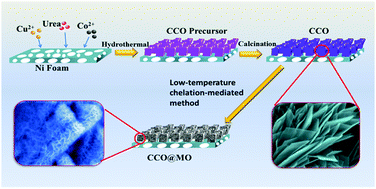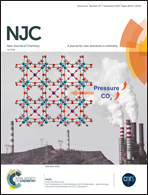Designed fabrication of three-dimensional δ-MnO2-cladded CuCo2O4 composites as an outstanding supercapacitor electrode material†
Abstract
Three-dimensional δ-MnO2-cladded CuCo2O4 composites are designed and grown in situ on Ni foam via a simple hydrothermal reaction and subsequent one-pot chelation-mediated aqueous processes. The electrode architecture can take good advantage of the synergistic effects contributed by both the porous CuCo2O4 nanoflake core and the δ-MnO2 shell layer. When δ-MnO2-cladded CuCo2O4 composites, along with porous Ni foam, are employed as a binder-free electrode for supercapacitors, the hybrid electrode shows higher specific capacitances and a better rate capability than the single CuCo2O4 nanoflake electrode. A maximum specific capacitance of 1180 F g−1 is achieved at a current density of 1 A g−1 and 81.7% of this value remains at a high current density of 10 A g−1. Moreover, the δ-MnO2-cladded CuCo2O4 electrode also delivers an excellent cycling stability, maintaining 93.2% at 15 A g−1 after 5000 galvanostatic charge–discharge cycles. Moreover, according to electrochemical impedance spectroscopy (EIS) analysis, the δ-MnO2-cladded CuCo2O4 electrode possesses a lower equivalent series resistance of 0.78 Ω and a charge transfer resistance of 0.09 Ω. In view of its cost-effective fabrication process and excellent energy storage properties, this unique integrated nanoarchitecture would hold great promise in the field of electrochemical energy storage.



 Please wait while we load your content...
Please wait while we load your content...